Peter MALONE
Saturday, 09 October 2021 13:01
Avalanche/ 1946
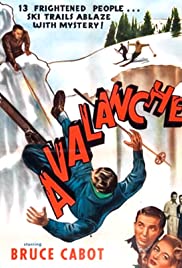
AVALANCHE
1946, 70 minutes, Black-and-white.
Bruce Cabot, Roscoe Karns, Helen Mowery, Vida Ann Borg, Regina Wallace, John Good, Philip Van Zandt, Eddie Parks.
Directed by Irving Allen.
Avalanche is a curiosity item in the history of cinema rather than an entertaining action and detection film in itself. It is a story of two Inland Revenue agents who track down a debtor in the snowfields of Idaho. Eventually, they are snowed in and find the debtor dead, murdered, as if he had been killed in an avalanche.
There is a variety of suspects at the resort. Standing out his tough actress played by Vida And Borg, with her husband, an older woman who is infatuated with the dead man, but also to offended by her meek husband. And a young woman with the skiing of the resort.
Bruce Cabot, memories of King Kong, rather stolid as the main investigator. But there is some comedy by Roscoe Karns as his associate, not liking the cold and the snow, finding that the crow ever-present who works at the bar actually talks to him. At one stage, there is a marionette puppet performance, with touches of the sinister.
In fact, there are mistaken identities, ski scenes, an elaborate escape sequence through the snow, and a number of people trying to recover the cash brought by the alleged dead man.
The main interest is in the fact that it is the first feature film directed by Irving Allen, who won Academy Awards for short films in 1946 and 1947. His work as a director is rather undistinguished. However, he has an excellent catalogue of films produced between the 40s and the 70s. And, the production manager of this film is someone he went to college with, Albert Broccoli – who, of course, was a producer of the James Bond films.
Published in Movie Reviews
Published in
Movie Reviews
Saturday, 09 October 2021 13:01
Walk the Dark Street
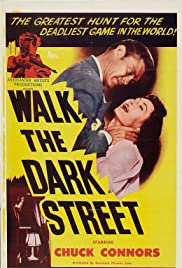
WALK THE DARK STREET
US, 1956, 73 minutes, Black-and-white.
Chuck Connors, Don Ross, Regina Gleason, Vonne Godfrey, Eddie Kasafian, Wyott Ordung.
Directed by Wyott Ordung.
This is a small budget supporting feature. It was written and directed by Wyott Ordung, who wrote and directed a number of small films. It features Chuck Connors at the beginning of his career.
The film opens with a man walking down a dark Los Angeles street, carrying a rifle in a container, hearing a tyre burst and falling to the ground. The film then goes into flashback, a sequence during the Korean War, the falling man the lieutenant and his friend now critical of him, writing a letter to his brother that if he should die, the lieutenant was to blame. He rushes over the top and is killed.
On return, the lieutenant goes to see the brother, played by Chuck Connors. He is a hunter and has many trophies. However, he also has a bad heart. He was possessive of his brother and now proposes a variation on The Most Dangerous Game, the two of them with rifles, camera rifles rather than bullets, should hunt each other through the city for 48 hours, the lieutenant getting $10,000 for his sporting business if he wins.
There are various scenes of stalking – and amazement now that people could carry rifles in plain sight through the streets of Los Angeles, though the brother is picked up by the police and interrogated. The lieutenant goes to a nightclub, picks up a girl who is ready for him, the dead man’s girlfriend who is against the older brother who was forbidding his brother to marry her. There is also a scene between the brother and his girlfriend.
With various warnings, the stalking begins again, a final confrontation, the brother collapsing, the revelation that each of the guns had a bullet rather than a camera.
An interesting idea – but executed very much in the style of the poverty row supporting features.
Published in Movie Reviews
Published in
Movie Reviews
Saturday, 09 October 2021 13:01
Romantic Road
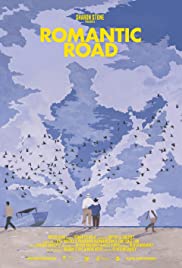
ROMANTIC ROAD
UK, 2017, 82 minutes, Colour.
Rupert and Jan Grey.
Directed by Oliver Mc Garvey.
Is “grey nomads� the title that applies to older travellers as they drive around the countryside, enjoying retirement, getting to know their world better, making friends with similar nomads that they meet in their journeys a title used around the world? Are their British grey nomads.
The title for this grey nomad adventure is Romantic Road. That seems to be an understatement title. It certainly is the story of her husband and wife who get on very well together, she supporting her husband in his ambitious travels, his risk-taking. They have had a long time romance, over three decades. But, romantic isn’t exactly the word that describes where they go, what they experience, the rough terain that they travel through, tough times, mechanical difficulties as well as bureaucratic barriers.
Our travellers are, literally, Grey nomads.
This is a story of Rupert and Jan Grey, he a London lawyer. His father served in World War II in India and so he has affinity with the subcontinent. And his father bought a Rolls-Royce? in 1959, not only still-going, but the star of this trip. And, it is a Rolls- Royce - and Rolls- Royce advertising and publicity will definitely be pleased with how their vehicle stands up after more than 50 years!
The travels are in India, in 2013. Northern India. Starting from Mumbai, North to Jodhpur, but across the top to Nepal and views, of course, of the Himalayas. But, in fact, the destination is Bangladesh, a photography festival in Dhaka because Rupert Grey is an enthusiastic photographer and has good contacts in Bangladesh. (Actually, towards the end of the film, despite preparatory visits to the country, he comes up against the sometimes nit-picking bureaucratic tangles about whether he can bring his Rolls across the border – and whether he can drive out and back into India.)
We are nicely introduced to Rupert and Jan, testimonies from their daughters, from many of their friends, touches of admiration, and many touches of humour. And we share in the preparations, studying the maps, contacts with the photography festival, making sure that the Rolls is in top working order (spoiler, not always).
Of course, the film serves as an enjoyable travelogue, many telling vistas of Mumbai, the northern desert and the city of Jodhpur, the atmosphere at Katmandu, the mountainous and winding roads leading south, the coastal areas of Bangladesh and into the city of Dhaka and, on the way home, a visit to Kolkota and, Bangalore. For those who enjoy travelogues, plenty to see and to relish.
But this is a story of an older couple, their bonding with each other, their sharing this adventure, and enterprise, and achievement.
And the film has a great deal of appeal to a wide audience, but especially to international grey nomads.
Published in Movie Reviews
Published in
Movie Reviews
Saturday, 09 October 2021 13:01
Agatha Christie's Poirot Adventure of Johnny Waverley
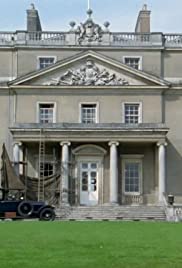
THE ADVENTURE OF JOHNNIE WAVERLEY
UK, 1989, 50 minutes, Colour.
David Suchet, Hugh Fraser, Philip Jackson, Pauline Moran, Geoffrey Bateman, Julia Chambers, Dominic Rougier, Patrick Jordan.
Directed by Renny Rye.
This is an early contribution to the 70 television films of Agatha Christie mysteries with David Suchet as Poirot. In fact, it is the third film. (In the early films, Poirot is somewhat sharp with people, in this film with Hastings after a car breaks down. He mellowed much more in the following films.)
As soon as the father and mother of the boy who is abducted appear, it seems pretty evident that the father will be the villain, a very unpleasant husband towards his wife, arrogant with Poirot, insultingly aggressive to Chief Inspector Japp. He wants Poirot’s help because he has a message that his son will be abducted at midday the next day. He complains that the police have done nothing – although Inspector Japp comes down with a squad of police to prevent the abduction.
Mr Waverley describes himself as a squire of the land, with an ancestral home which is being renovated, but he has run out of money. He dismisses most of his staff, suspicious of them. His wife becomes ill the night before the kidnapping.
We suspect that Mr Waverley is responsible for the abduction, has concocted the whole event along with his long-time butler and the butler’s niece.
No murders, not as much excitement as in other episodes, but Poirot realising what has happened.
1. The popularity of the television series of Agatha Christie mysteries with Poirot played by David Suchet?
2. Poirot and the block of flats, his office, Miss Lemmon and her filing system, Hastings and his interest in cars, the visit of Mr Waverley, while responding, visiting Chief Inspector Japp, Waverley insulting him because of the lack of police response to the messages?
3. Hastings driving to the home, Poirot on the train, the conversations with Mr Waverley, Mrs Waverley, the boy playing with his nurse?
4. The formality of the dinner, the mother upset, the boy going to bed? Poirot awakening in the night, Mrs Waverley and her illness? Her being confined to bed the next
day?
5. Some humour about English breakfast, the fish and rice, going to the cafe for the proper breakfast? Hastings driving, the two singing, the car breaking down, Poirot walking through the fields?
6. Japp and the police, guarding the house, the clock put forward, the intrusion of the tramp, the message? The boy disappearing during the upset?
7. Poirot, the puzzle, the interview with the butler, the issue of the priest’s hole? Poirot, Hastings, the tunnel, Poirot working out what happened, demanding that Waverley take them to the boy, the role of the butler, his niece minding the boy? Waverley wanting money for the renovations and his status from his wealthy wife?
8. Poirot, solving mysteries? Hastings accompanying him? On the verge of more telling and mysterious stories?
Published in Movie Reviews
Published in
Movie Reviews
Saturday, 09 October 2021 13:01
Millerson Case, The
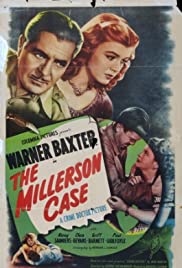
THE MILLERSON CASE
US, 1947, 72 minutes, Black-and-white.
Warner Baxter, Nancy Saunders, Clem Bevans, Griff Barnett, Paul Guilfoyle, Addison Richards.
Directed by George Archainbaud.
Despite the title, and this is one of the series of the Crime Dr mysteries, a popular series during the 1940s, B-budget from Columbia Studios.
This film is quite different, the action not taking place in the city or in the doctor’s office – except at the beginning when he decides to go on vacation. He drives to the mountains for hunting, finding a rather hillbilly community, the setting in West Virginia.
He doesn’t get time to do the hunting because there is a typhus outbreak in which he assists. There is also a murder and he joins with the local doctors and the police to solve it. The plot uncovers some smouldering passions underneath the hillbilly surface, and some deaths in vengeance, as well as to prevent the discovery of the murderer.
Paul Guilfoyle frequently plays criminals and looks rather sinister in this one – but turns out to be one of the good guys!
Quite a lot of the dialogue concerns holding onto traditions of medicine and law enforcement out in the mountains and the need for entering into 20th century methods.
1. Part of the series of the Crime Doctor murder mysteries and investigations? Dr Ordway, his New York practice, going on vacation, to West Virginia, typhus and murder?
2. The New York settings and office, the West Virginia town, shops, streets, homes, the local fair? The musical score?
3. Audience familiarity with Dr Ordway? Age, experience, character? Arriving in Brooke Falls, meeting Jud, his guide, the plan to hunt and fish?
4. The house, Mrs Millerson, the boy shot, the doctor, the old-fashioned medicines, the long traditions? His clash with the doctors at the local clinic?
5. The old-fashioned ideas of the people in West Virginia, rather unflattering? The sheriff, the judge, shopkeepers, playing cards? The barber and his collapse? At home, his upset wife, flirtatious sister-in-law? His death? The later revelation about his womanising, Jud’s wife, the poisoner’s wife, the funeral?
6. The local doctors, welcoming Dr Ordway, the local law enforcement? The collaboration in investigation? The range of interviews, pieces of information, the picture of the barber, of the women (and their anger with each other and the public fight in the street)? The doctor, his hostility? The illiterate worker and his angers?
7. The local fair, the enthusiasm, the games and competitions? Dr Ordway setting up the shooting competition? The candidates and the revelation about the shooting?
8. The note, the doctor going to the pool, his being shot?
9. Further investigations, the suspicions on Jud, the hypnosis? The doctor going to see the little girl, buying the doll, her writing the note for her father? His anger and vengeance? And shooting the doctor? Arrest, imprisonment, his behaviour and mental condition? The doctor testing in with the paper on fire and his taking the bait?
10. Dr Ordway as a catalyst for change, always agreeable rather than threatening? Fishing next year?
Published in Movie Reviews
Published in
Movie Reviews
Saturday, 09 October 2021 13:01
Crime Doctor's Strangest Case, The
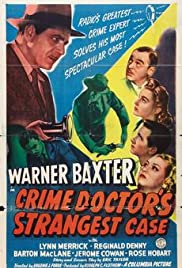
THE CRIME DOCTOR'S STRANGEST CASE
US, 1943, 68 minutes, Black-and-white.
Warner Baxter, Lloyd Bridges, Lynn Merrick, Gloria Dickson, Barton McLane?, Jerome Cowan, Reginald Denny, Rose Hobart, Virginia Brissac.
Directed by Eugene J.Forde.
The Crime Doctor was a very popular series in the 1940s, B-budget from Columbia Studios, supporting features. The stories were based on a very popular radio program. This is the second in the series, the initial film introducing Warner Baxter, Oscar-winner for In Old Arizona, 1928, and explaining his background, crime, amnesia, parole board, psychiatrist.
Lloyd Bridges plays a young man accused of murdering his employer. He was helped by the doctor in the past for a new trial. He is now intending to marry, visiting the doctor with his fiancee, explaining that he has a similar kind of job to the past. The doctor intends to visit his employer but arrives to find that has been poisoned. The young man declares his innocence, makes an escape, is found to have married his fiancee and takes refuge with her.
At the house, the doctor is welcomed by an eccentric housekeeper of 30 years, a former showgirl, an intriguing dotty performance by Virginia Brisssac. There is the dead man’s brother who runs a pharmaceutical company. There is a dead man’s wife of only one year. There is also the nephew of the dead man. Also present is the housekeeper of six months.
There is a great deal of plot in the one hour plus running time. The doctor investigates the past of the dead man, getting information about his partner of the time who disappeared, allegedly embezzling all the money. The man who disappeared also had a daughter at the time – and it is she who is disguised as the housekeeper at the mansion. She has a most eccentric husband, a popular song composer, played by Jerome Cowan.
Much of the action takes place in the club owned by the two men, shut for 30 years, though the dead man paying taxes – and the corpse of his partner being found. There are various people lurking in the club, a dangerous fire but the doctor escaping. The dead man’s brother is also found hanged in the club.
Eventually, a confrontation, a visit to the club and the unmasking of the villain.
1. The popularity of the Crime Doctor series? Mysteries? Investigations, the doctor and the police? Based on a popular radio program?
2. Warner Baxter as the doctor, screen personality, background, psychiatrist, crime investigations?
3. The settings, the doctor and his office, the mansion and the interiors, the decayed nightclub, dark and sinister settings? The musical score?
4. The doctor, personality, his work, with Jimmy, helping him in the past with his trial, giving advice to him and his fiancee, going to see the employer, discovering the murder, the information from Miss Patricia, meeting those present, wife, brother, nephew, the housekeeper? Suspects?
5. The difficulties for Jimmy, talking with the doctor, but running away, fear that he would not be believed, going to his fiancee, the discovery that they were married? The club, the fiance going to visit with the doctor? His eventually being vindicated?
6. The doctor, the confrontation with the housekeeper, the audience seeing her changing her clothes, wig, transforming from dowdy to blonde in her early 30s? Her escape? The doctor tracking her down, her musician husband, his eccentric behaviour, the danger with fires? The arrival of the police, to charge him? The fire on the police car? The revelation of who the housekeeper was? Daughter of the partner of the dead man?
7. The dead man, explanations, his double dealings, his partner and the birth of his daughter, his disappearance with the money? The discovery of the corpse in the club? The dead man paying taxes for 30 years? The flashbacks – and Miss Patricia as a dancer?
8. Miss Patricia, her devotion, the past, eccentric behaviour, advice to the doctor?
9. The doctor returning, climbing the ladder, the dead man’s wife and her fears? The doctor reassuring her?
10. The episodes in the club, the darkness, the lamp, the fire? The dead body? The brother found hanging?
11. The police, collaboration with the doctor, his eluding them?
12. The buildup to the confrontation, the return to the club, the nephew and his presence, prepared to shoot the doctor, his being recorded? Unmasked?
Published in Movie Reviews
Published in
Movie Reviews
Saturday, 09 October 2021 13:01
Agatha Christie's Poirot Adventure of the Italian Nobleman
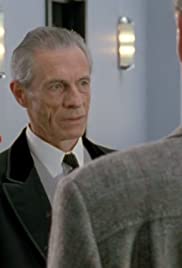
THE ADVENTURE OF THE ITALIAN NOBLEMAN
UK, 1993, 50 minutes, Colour.
David Suchet, Hugh Fraser, Philip Jackson, Pauline Moran, Leonard Preston, Anna Mazzotti, David Neal, Vincent Riotta.
Directed by Brian Farnham.
One of the later episodes in the short stories in the television series based on Agatha Christie mysteries with David Suchet as Poirot.
The Italian nobleman of the title ultimately is revealed as a blackmailer – which leads to the Italian Embassy, denials of the First Secretary, and Embassy official going to Poirot, a mysterious Italian with a case of documents, and Italian car dealer and his assistant and issues of blackmail.
Hastings is seen buying an Italian car, hesitating but finally making a decision. Miss Lemon is seen as meeting a date, with a man who says he is a secretary to a political figure. The alleged political figure, the Italian nobleman, is murdered, a suspicious visit from the mysterious Italian with the suitcase. The man dating Miss Lemon is invited to tea with Poirot and is surprised to find Poirot and Hastings at the scene of the murder, and his position revealed as a valet.
Chief Inspector Japp is also involved in the investigation.
There is a climax at a harbour site, a boat for an escape out of England, and a car chase around the town.
A satisfactory solution to the mystery.
1. Popularity of the Christie mysteries? The television series? David Suchet as Poirot?
2. The atmosphere of the 1930s, political, Italy, pictures of Mussolini? Poirot’s office? The car sales? Apartments? Chichester and the sea, the walls, the car chase? The musical score?
3. The title? The Italian background? Italian cars and sales? Italian personnel at sales? The count, political connections, the First Secretary at the Embassy? The count, his valet, his murder? Intimations of blackmail?
4. Hastings, his love of cars, the discussions, the sale, his hesitation, final decision? His delight in driving the car? In the car chase? The crash? His car and issues of payment and insurance?
5. Miss Lemon, her role as secretary, her going out on the date, her return, Hastings’ reaction, Poirot’s invitation for the young man? His coming to tea, timid in manner, secretary’s account, the political discussions, the story of the Navy, the photo of his boat?
6. Sinister goings on at the car sales, the Italian manager, the saleswoman, talk of her uncle and the visit, Hastings observing? The death of the count? Hastings and Poirot going to the Italian wedding celebration? The young woman’s reaction?
7. The scene of the murder, Poirot and Hastings, the issue of the meal, the curtain not drawn, the cups, fingerprints, Poirot interviewing the chef? Chief Inspector Japp arriving later?
8. Graves, discovering that he was the valet, his self-promotion, his story?
9. The mysterious Italian, the Embassy, documents, money, the case? Graves telling the story of his visits? Graves and his fabricating the stories? The Italian, hiding in the hotel,
the truth about the documents? Is Trying to burn them?
10. Poirot and the further investigations? Uncovering Graves as the killer? The explanation?
11. Graves, trying to leave the country, his boat, Hastings remembering the photo, Chichester? The police? The car salesman and the assistant? Searching the boat?
12. Graves, his driving, seeing the police, his turning around, the chase and pursuit, Hastings driving? The crash?
13. Graves and his taunting of Poirot? And the reason for his visiting Poirot in the first place – and the challenge?
14. The postscript, Miss Lemon’s feelings, and her reaction about Graves and his not doing anything about the cat!
Published in Movie Reviews
Published in
Movie Reviews
Saturday, 09 October 2021 13:01
Shadows in the Night
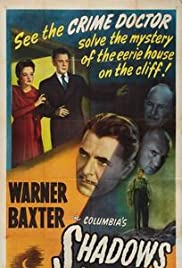
SHADOWS IN THE NIGHT
US, 1944, 67 minutes, Black-and-white.
Warner Baxter, Nina Foch, George Zucco, Edward Norris, Lester Matthews, Ben Welden,, Jeanne Bates.
Directed by Eugene J.Forde.
Shadows in the Night is the third in the B-budget supporting feature series, based on a radio program, the Crime Dr. The series continued throughout the 1940s and starred warner Baxter, Oscar-winner for In Old Arizona (1928).
The doctor is asked to investigate the nightmare experiences of a rich young woman, played by Nina Foch, with fears for her life. The doctor visits her house, changes rooms with her, experiences the same nightmares and sleepwalking, almost causing his death.
There is a variety of guests in the house, a pompous actor and his wife, a lawyer, the young woman’s scientist uncle who has his own laboratory, a young man partner in a company whose head is found dead, and the jack of all trades who works on the property.
There are suspicions on the uncle, especially with the poisons in his laboratory. There is suspicion on the lawyer. Initial suspicions on the handyman – who is able to provide help to the doctor and for the solution. There is a comic touch as the coroner is sprayed with the hallucinating powder and sleep walks – very difficult to wake up and asserting that the gas had no effect on him.
Eventually, of course, the culprit is unmasked, hostility towards the young woman, issues of custodianship and divorce.
1. The third in the Crime Doctor series? The popularity of the stories, based on a radio program, murders and mysteries? Dr Ordway and his investigations and solutions?
2. The setting, the mansion, the sea, the cliffs? The interiors, basements, laboratories? The musical score?
3. The title, dreams and nightmares, the hypnotic gas and the consequences?
4. Dr Ordway, at home, Lois Garland and her visit, fears, nightmares? The doctor reassuring her, her going home? The man at the window, listening at the door, his footprints?
5. Dr Ordway going to the house, Nick at the gate, Lois welcoming him, meeting with Mr and Mrs Carter, the actor and his performance, the other guests, Frank Swift, looking sinister, his laboratory? Lois’s uncle? Jess Hilton, the partner in the business? Relationship with Lois?
6. Dr Ordway sleeping in Lois’s room? The gas, his sleepwalking, the accident on the cliffs, Frank Swift helping him? Seeing the dead body in the corridor? Its disappearance? Later finding it on the beach? The dead manager of the firm?
7. The police, interrogations? The doctor and his search of the house, the laboratory and the gas? The basement? Nick and his role, prison, chef, suspicious?
8. Frederick Gordon, attorney, his place as a guest? Under suspicion?
9. The police, the doctor, the demonstration of the gas, his denying its power, his sleepwalking, difficult to wake up? The comic touches?
10. The back story Stanley Carter, custody issues, animosity towards Lois, the gas, the roof, the whole and the insertion of the gas and its effect on Lois? Nightmare and fears?
The re-enactment of the coroner disguised as the mysterious woman?
11. Carter, his being tied up, Nick giving a demonstration of tying himself up, the unmasking of Carter?
Published in Movie Reviews
Published in
Movie Reviews
Saturday, 09 October 2021 13:01
Crime Doctor's Man Hunt, The
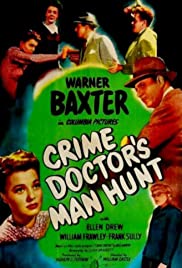
CRIME DOCTOR'S MAN HUNT
US, 1945, 61 minutes, Black-and-white.
Warner Baxter, Ellen Drew, William Frawley, Claire Carelton, Francis Pierlot, Myron Healy.
Directed by William Castle.
By the end, the title is misleading. It turns out to be a woman hunt.
This is one of the series of the Crime Doctor mysteries, B-budget supporting features from Colombia Studios throughout the 1940s. The audience sees a bewildered young man at fair, passing a shooting gallery. He later goes to ask help from Dr Ordway. Soon afterwards, Dr Ordway confronts some thugs who have killed the young man. The doctor pretends to be drunk, notes the house where the group came from, in collaboration with the police, begins investigation.
The young man’s fiancee had also come to visit Dr Ordway. She is wealthy, has an older sister who took care of her but who has clashed with their father and left the house.
The investigation involves the young woman at the shooting gallery spending time in prison – but, eventually being able to identify a mysterious woman who visited the gallery. In fact, she has taken one of the guns, set up the abduction of the young man, his death, the cover-up, using a house which is now deserted, her father paying the rent, the house where her mother died.
The doctor and the police set a trap – and, the revelation is that the fiancee, mental problems, has assumed the identity of her sister and perpetrated the crimes.
1. The popularity of the Crime Doctor’s series, Warner Baxter as Dr Ordway? Age and experience, medical, psychological, police investigations, collaboration with the police?
2. The city settings, the streets, apartment blocks, abandoned buildings, mansions, the fair and the shooting gallery? The musical score?
3. The gallery, Philip Armstrong and his wandering, lost, the talking with Ruby, her offering him the shots? His returning, bewildered? His visiting Dr Ordway in his office? Disappearing? Dr Ordway returning home, the men in the street, carrying the dead Philip, his pretending to be drunk, their driving him home?
4. Dr Ordway and his contact with the police, William Frawley and his comic touches as the investigator, his forever making demands on his subordinate, Bradley? The return to the house, the grumpy landlady, the other guests? Ruby and her presence? Interrogation?
5. Dr Ordway going to see Gerald Cotter? Irene and her previous visit, her concern about her fiance? The revelation of his name? Her father, the older sister and her being dismissed, bringing up Irene, the hostilities? Her being under suspicion?
6. The further investigations, the gun responsible coming from the shooting gallery, Ruby and her being put in prison? Dr Ordway and his concern?
7. The visit to the abandoned apartment, the shrine to Cotter’s wife? The fire? The gas explosion in the apartment, the men’s deaths?
8. The melodramatic entrance of the sister’s husband and his tantrums?
9. The mysterious character, Blind, glasses, tough, the commission, her refusing to pay the money? Ruby remembering her, linking her to the gun?
10. The setup, the police, the room, Irene coming to visit – and the revelation about her psychological state, her impersonating her sister, the deaths?
11. By the end, the title being misleading!
Published in Movie Reviews
Published in
Movie Reviews
Saturday, 09 October 2021 13:01
Crime Doctor's Warning

THE CRIME DOCTOR’S WARNING
US, 1945, 70 minutes, Black-and-white.
Warner Baxter, John Litel, Dusty Anderson, Coutler Irwin, Miles Mander, John Abbott, Eduardo Cianelli, Franco Corsaro.
Directed by William Castle.
Another in the popular series from the 1940s from Colombia Studios, B-budget supporting films starring Warner Baxter as a psychiatrist who is also skilled as a detective.
This story takes place in the art world, an artist visiting Dr Ordway, experiencing loss of memory at various times. The artist is ambitious, not just to be a commercial artist, has a studio – but is dominated by his severe mother, wheelchair-bound.
A model is murdered and Dr Ordway brought into the investigation. The artist is in a relationship with another model – and she is found murdered in his room. He is arrested, preferring to stay in prison than go to an institution ordered by his mother. Also involved is a flamboyant fellow-artist, his model for many years, mail, who is against female models. There is an also an art dealer (named Malone). The plot is quite complicated, the doctor tracing the actions of the murderer, finally unmasking him, and the young artist freed. (And the villain is Malone!)
1. The popularity of the Crime Doctor series? B-budget, supporting features? The doctor himself, his background, psychiatry, police investigations? Warner Baxter, his screen presence? Medical help? Police investigation? Solving cases?
2. Dr Ordway and his practice? His office, Clive Lake and his visit? His interest in the case? His investigations, interviews, visits? His collaboration with Inspector Dawes? Friendly relationship? The visit to the artist’s studios? Climbing to the roof and getting into the locker room? The key? The attack on him and his home to get the key? His visit to Clive’s mother, her stern possessive attitude? His visit to the art gallery, the director, his giving the money for someone to buy Clive’s painting?
3. Clive, his psychological experiences, blacking out, his paintings, relationship with Connie, her posing, his painting, going up to the roof? At the party, his dancing? His hopes in painting? The dealer buying his painting and his being happy? Going to his mother, her domination? Going with Dr Ordway instead of to an institution? The discovery of Connie’s body under the bed? His arrest, in the cell, his not knowing what was happening?
4. Duval, his flamboyance, paintings, talent? His using Nick Petroni as model? Petroni’s eccentricity, Duval painting only male models? Petroni against female models? Potential killer? Duval, his demands for money? His being shot?
5. The story of the San Francisco painting? Jimmy Gordon and his cutting out silhouettes – including Dr Ordway? Suspicions of his murdering the model from San Francisco? His defiant attitudes?
6. The identity of the third model in the painting, Dr Ordway confronting the director of the Gallery, the wax figure of his wife?
7. The dealer, his motivations, his attack on Dr Ordway, the arrest? Clive and his rehabilitation?
Published in Movie Reviews
Published in
Movie Reviews